NACFE-sponsored program saw 7 trucks average 10 mpg during regular duty cycles
The myth of the 10-mpg truck has been proven wrong thanks to a group of seven drivers with seven differently equipped tractor-trailers driving for seven different companies.
While there are stories of individual drivers who have achieved 10 mpg, there has been no definitive study until now. NACFE, along with the Carbon War Room and sponsors Shell and PepsiCo, commissioned a group of truck drivers – ranging from an owner-operator to fleets with 7,000-plus trucks – to track their mileage during their regular daily duty cycles, which included 31 of 99 total days at over 65,000 lbs., as well as trucks that drove with headwinds and tailwinds from Hurricanes Harvey and Irma. All the trucks had different specs. According NACFE executive director Mike Roeth, the only real requirement was that the technologies used on the trucks needed to be commercial available.
The trucks in the study averaged 10.1 mpg overall, with 12.8 the highest individual mpg and three different trucks posting days over 12.5 mpg. The lowest mpg from a truck was 7.1 on one of the days, and the average for all lowest mpgs throughout the Run was 8.8. Collectively, the trucks traveled 50,107 miles and saved 2,877 gallons of fuel and $7,183 over the national fleet-wide average of 6.4 mpg.
“One of the things we thought about with Run On Less was whether this was an mpg contest,” Roeth said during a press conference Sunday at the North American Commercial Vehicle Show at the Georgia World Congress Center in Atlanta. “But what these fleets did was they brought trucks with equipment that works.”
The trucks came from Albert Transport, PepsiCo’s Frito-Lay Division, Hirschbach, Mesilla Valley Transportation, Nussbaum Transportation, Ploger Transportation, and US Xpress. There were three Freightliner models, two Internationals, and two Volvos driven by experienced drivers Henry Albert, Bradley Long, Tommy Revell, Roberto Sandoval, Joel Morrow, Clark Reed, and Mark Risien.

There were some common specs on the vehicles, such as aerodynamic treatments, including skirts and rear deployment aerodynamic devices, but also some unique equipment – such as the Ploger unit which included lift axles on both the Volvo tractor and trailer. Henry Albert, the owner-operator, does not equip his tractor with an APU, but rather uses solar panels to charge auxiliary batteries. Other technologies included engine accessories, tire pressure systems, automated transmissions and low viscosity oils.
The results of the study will be posted in a downloadable spreadsheet on Runonless.com this week, Roeth said.
As an example of the conditions the trucks operated in, Roeth noted that on one day, a single truck achieved 3,270 ft. of elevation gain pulling 72,960 gross combination weight with an average 2.7 mph headwind and still achieved 9.7 mpg.
All the trucks were monitored with a Geotab device that monitored engine parameters and operating conditions. A more in-depth study of the data will be made available in the spring. The run concluded on Friday in Atlanta.
Morrow told FreightWaves he was actually a little disappointed in his truck’s mpg during the event, which was 10.5. “I was thinking 12.2, 12.3 going in,” he said, noting that his truck was one of the ones that faced headwinds from the hurricanes.
Morrow noted that he uses PedalCoach in his cab to “challenge myself every day,” and over his last 30,000 logged miles, he had averaged 10.47 mph driving a Volvo with I-Shift transmission. Primarily hauling furniture, Morrow estimates the lift axles on the cab and trailer are up about 70% of the time and that he maintains a consistent speed of between 58 and 63 mph. That is not a company mandated limit, he noted, but one he sets on himself because “you’ve got to want to get good fuel mileage.”
Albert, who is a member of Freightliner’s Team Run Smart, told FreightWaves that it is a misconception that only large fleets can achieve this kind of mileage. In fact, he said the real problem is that many owner-operators run their trucks “as drivers” and they need to “leave the driver at home.”
Albert’s truck is outfitted with plenty of aerodynamic advantages, including small items such as placement of the trailer license plate on the trailer bumper and not hanging below it to reduce drag. He advised owner-operators to attack the “low hanging fruit.”
There are also some tricks Albert has picked up along the way. For instance, while he runs side skirts on the trailers, his skirts are higher off the ground than many other fleets. The reason? While skirts closer to the ground create more fuel efficiency, they are also more likely to be damaged, so he sacrifices a bit of efficiency for cost control. He has run its current skirts for 8 years with virtually no damage to them – long since paying for themselves.
His Freightliner produces 400 hp. with 1,750 lbs.-ft. or torque at 975 rpm. He runs a Detroit DT12 automated manual transmission with a 2.1 rear axle ratio with active lube management, something he said produces 1.5% fuel efficiency gain.
The most common mistake owner-operators make, he said, is getting a truck with too large an engine which results in more weight and more wear and tear on components.
While the trucks in the study included many advanced technologies, they are revenue producing trucks making money for the drivers and fleets, showing that an investment in technologies to reduce fuel usage does, in fact, pay in the long run.
Interest in more about news and commentary on FreightTech and trucking breaking news? Subscribe to FreightWaves.







